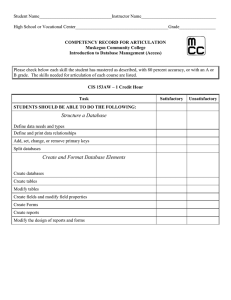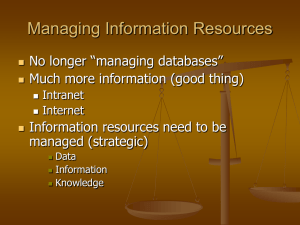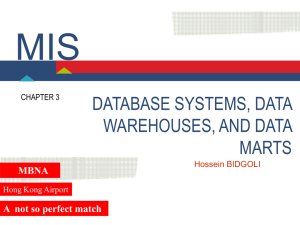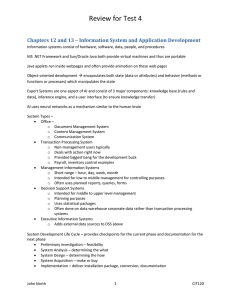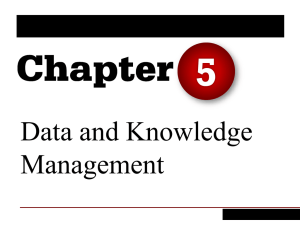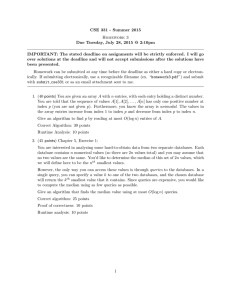INFORMATION SYSTEMS @ X INFO420: Managing the IT Function
advertisement
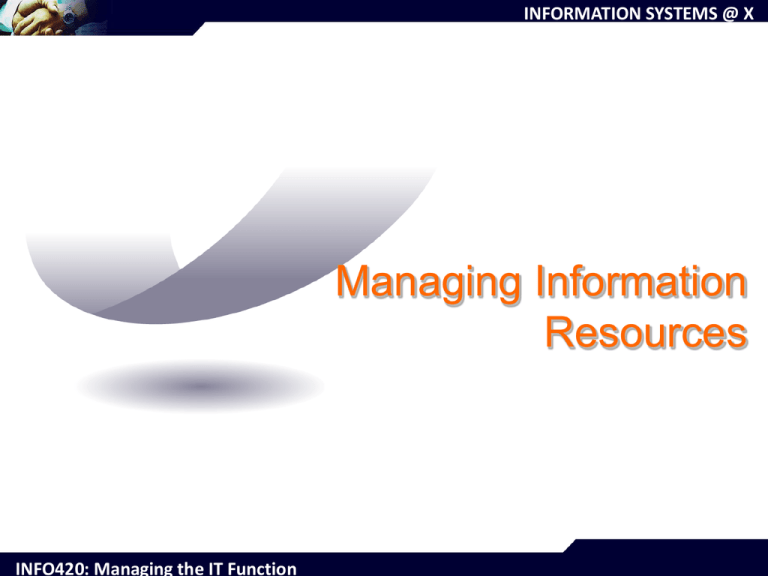
INFORMATION SYSTEMS @ X Managing Information Resources INFO420: Managing the IT Function INFORMATION SYSTEMS @ X This section… Identifies problems in managing data and approaches for management Discusses how technology Explores various types of information that companies need to manage Provides guidelines to management of knowledge (key organizational asset) INFO420: Managing the IT Function INFORMATION SYSTEMS @ X Introduction IS continually manages new forms of information resources Corporate databases Documents (electronic or paper) and Web content Knowledge management…expertise and experience Data—Information—Action! INFO420: Managing the IT Function INFORMATION SYSTEMS @ X Managing Data Data management Structured way data is represented, stored and retrieved for use. Database management systems (DBMS) are the main tool for managing corporate data Over time, a number of models have emerged (are emerging) for data management. Relational model Object Oriented model Document management increasingly important INFO420: Managing the IT Function INFORMATION SYSTEMS @ X Issues in managing corporate data Inconsistent Data Definitions Proliferation of databases / redundant data Data availability Data security Data integrity INFO420: Managing the IT Function INFORMATION SYSTEMS @ X Getting Corporate Data into Shape Role of Data Administration Administering databases and software that manages them to provide accurate and timely information to users Ensuring appropriate use of data > Most concerning: Customer Creating, managing and communicating standard definitions > Maintaining the corporate data dictionary Assuring quality INFO420: Managing the IT Function INFORMATION SYSTEMS @ X IHOP case What is the major data quality issue faced by Organization ? Why does Organization have this issue? What business problems did the data quality problem cause? What does ‘one version of the truth’ mean? INFO420: Managing the IT Function INFORMATION SYSTEMS @ X Managing Information Once enterprises get their data into shape, that data can more easily be turned into information “Information is power”: Mission: Put the right information, in the right hands, at the right time, in the right format INFO420: Managing the IT Function INFORMATION SYSTEMS @ X Managing Information cont’d Four Types of Information Internal record-based information—original focus of IS and most used in organizations > Found in databases Internal document-based information > Reports, emails, proposals, contracts External record-based information > Acquisition from external databases External document-based information > World-Wide-Web > Articles, books from a library INFO420: Managing the IT Function INFORMATION SYSTEMS @ X Four Types of Information Enterprise Systems (operational) Data Warehouses (decision support) Acxiom InfoBase WWW Books, articles Paper and Electronic Documents Internal web pages INFO420: Managing the IT Function INFORMATION SYSTEMS @ X Information management solutions Enterprise resource planning systems Data warehouses and business intelligence Electronic document management Content management INFO420: Managing the IT Function INFORMATION SYSTEMS @ X Enterprise Resource Planning ERP provides the means to consolidate data to give management a corporate-wide view of operations Functional integration Single repository of data supporting functional areas Standardized data definitions a must… “table stakes” But … too complex and not designed for reporting and analysis INFO420: Managing the IT Function INFORMATION SYSTEMS @ X Scenario The marketing department at the Bank of Nova Scotia wants to execute a marketing campaign aimed at increasing the loyalty of the banks best customers (those with portfolios more than $500,000). The analysts wants find the following information. Identify those customer that have more than $500,000 in loans, deposits and investments who have responded to at least one previous marketing campaign. Send a letter to each customer, offering a new investment product at a preferred rate Determine who responded to the marketing offer by purchasing the investment product during the bank’s 3rd fiscal quarter INFO420: Managing the IT Function INFORMATION SYSTEMS @ X Scenario - Systems Banking Systems Loan System Loan & Customer data Marketing System Investment System Deposit System Marketing System Investment & Customer data Deposit & Customer data Marketing & Customer data Questions: 1. 2. 3. 4. How would the marketer find out who has a portfolio more than 500,000 in loans, deposits and investments? What do you think the impact on the banking systems would be when running queries? Which system should supply customer data for addressing letters to best customers How would the marketer determine who responded to their offer and when? INFO420: Managing the IT Function INFORMATION SYSTEMS @ X The Answer In reality, this scenario could not be carried out without some form of data warehouse because: Queries would take days or weeks to create and perfect. The technical skills and knowledge required to construct the queries would require a team, not just one individual. Queries performance would be excruciatingly slow (days?) Performance of operational systems would be adversely impacted There would be numerous data integrity issues to overcome. INFO420: Managing the IT Function INFORMATION SYSTEMS @ X Data Warehouses INFO420: Managing the IT Function INFORMATION SYSTEMS @ X Data Warehouse … … … Reporting Analysis Data Warehouse “Sales” Operation Data Operation Data INFO420: Managing the IT Function Spreadsheets Charts “Acxiom”: 72 data points External Data External Data INFORMATION SYSTEMS @ X Electronic Document Management Documents more pervasive and fundamental than anything else in an organization. Paper still plays a major role in most enterprises Need to move seamlessly between digital and print Electronic document management (EDM) uses new technologies for document management to produce significant impacts Business process redesign Quality improvement INFO420: Managing the IT Function INFORMATION SYSTEMS @ X Traditional Publishing vs. Modern Process INFO420: Managing the IT Function INFORMATION SYSTEMS @ X Electronic Document Management Use of technology to support processes generates significant business value (transaction) Reducing physical space Faster routing Managing and tracking work flow and load New (info based) products and services INFO420: Managing the IT Function INFORMATION SYSTEMS @ X Content Management Corporate intranets (Web content) now replace print documents Necessary to support scale of e-business operations Automation of content Content is no longer static, but interactive INFO420: Managing the IT Function INFORMATION SYSTEMS @ X Content Management cont’d To create a content management strategy, companies need to understand the three phases of content Managing content creation and acquisition Content administration and safeguarding Content deployment and presentation INFO420: Managing the IT Function INFORMATION SYSTEMS @ X Content Management Source: Adapted from Chuck, Tueber, Dealing in Web Currency, Gartner EXP, 56 Top Gallant, Stamford, CT, June 2001. INFO420: Managing the IT Function
